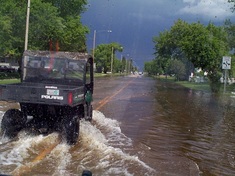|
April 2019
Water quality standards a main reason for decline in major pollutants

As people in the Twin Cities prepare to hit the water as the weather warms up this year, they can be reassured that water quality is improving – by some measures - in the major rivers passing through the metro area.
Three common pollutants are decreasing in the Mississippi, Minnesota and St. Croix rivers, according to long-term monitoring and statistical trend assessment by the Metropolitan Council Environmental Services (MCES). The MCES “Regional Assessment of River Water Quality” report, released in 2018, analyzes water quality data over a 40-year period. Concentrations of sediment, phosphorus and bacteria (measured as fecal coliform) have all “significantly decreased” across the three rivers from 1976-2015.
Water quality standards set by the Minnesota Pollution Control Agency (MPCA) - and implemented by cities and other local partners - are one main reason for the decline in pollutants.
Other factors include:
- Completing projects designed to meet the standards
- Investing in wastewater treatment
- Legislative ban on phosphorus in products like detergents and lawn fertilizer
- Regulations on urban stormwater runoff
- Changes in agricultural practices, including conservation tillage and manure management
- Implementing best management practices like erosion control and rain gardens
While the report demonstrates positive long-term trends that indicate improvements in water quality, more work still needs to be done to keep reducing pollutants so that the water quality meets standards.
The report also notes the need to take action on increasing nitrate and chloride levels in the rivers:
- Chloride concentrations have increased across all three rivers, and in recent years these concentrations have been highest near the central urban areas of Minneapolis and Saint Paul, where winter road salt usage is a significant source.
- Nitrate levels have also significantly increased across all three rivers during the last 40 years, with highest levels found in the Minnesota River in recent years, due to the predominance of agriculture in the river’s basin. This in turn affects the metro Mississippi River, as the MCES observed increases in nitrates downstream from the confluence with the Minnesota River.
The report recommends continued collaboration among state, regional and local partners, including these steps:
- Establish a water quality standard for nitrogen
- Educate citizens and cities on efficient chloride use to reduce the amount reaching streams and lakes
- Continue long-term monitoring of metro area rivers to stay informed on any changes in water quality
For the full report, visit: https://metrocouncil.org/river-assessment.
|

The MPCA recently recognized 334 Minnesota wastewater treatment facilities for maintaining outstanding permit compliance from October 2017 through September 2018.
The awards were presented at the 82nd Annual Wastewater Operations Conference in Brooklyn Park. The annual conference brings together wastewater operators from Minnesota for training and professional education. MPCA Deputy Commissioner Peter Tester presented the certificates and praised award recipients for their persistent work and dedication to protecting water quality.
To be eligible for this recognition, facilities were required to:
- Submit all reports to the MPCA correctly and on time
- Demonstrate consistent compliance through monitoring, operations, and maintenance
- Employ staff certified by the MPCA in wastewater operations
Minnesota has about 1,600 municipal and industrial wastewater treatment facilities. Community, institution, or treatment plant size was not a factor in awarding the certificates.
A complete list of winners is available on the MPCA’s Wastewater Treatment Facility Operations Award webpage. Photos of recipients who picked up their awards in person are available through Google Photos. Be sure to submit the photo to your local media and post on your community’s website for recognition.
Photo above: Dustin White, Rick Ashling and Matt Larson of the Albert Lea WWTF accept their award from Peter Tester, MPCA deputy commissioner (third from left).
|
The 2019 Collections Systems and Wastewater Treatment Conferences took place on March 25-29. More than 800 people attended this year’s conferences that highlighted the importance and complexity of work that certified operators are engaged in every day. The conferences included more than 150 presentations, workshops, exam sessions, and break-outs along with networking, relationship-building, and recognition that occurred in the hallways, over lunch, and at the awards open house. These conferences represent an incredible opportunity for the industry to share information, connections, resources, and development opportunities.
The 2020 Conference Planning Committee will convene in September 2019. Please contact Don Berger if you are interested in helping plan the 2020 conferences: Donald.Berger@state.mn.us.
The MPCA is beginning the process of completing the Wastewater Infrastructure Needs Survey (WINS) and Report as required by Minnesota law (statute 115.03, sub. 9). This survey assesses the current condition and future needs of Minnesota’s publicly owned wastewater treatment and conveyance infrastructure. The survey results help determine what Minnesota communities require to address their wastewater needs, and what role the state of Minnesota will play in providing resources and assistance.
You should expect to receive an email in May 2019 that contains a link to the WINS survey. Below are some quick facts about the survey:
- You may forward the survey email on to others to fill out portions of the survey.
- You may save your work and exit the survey at any time; however, once survey portions are submitted, you may not go back into them.
- Data from the 2017 WINS will populate the survey so you will only need to provide updates to that data or answer new questions for 2019.
- A detailed instruction document will be sent out with the survey.
Thank you for your continued participation in the electronic WINS process. For more information, contact Cara Omana at the MPCA: 651-757-2891 or cara.omana@state.mn.us.
The Minnesota Public Facilities Authority (PFA) recently announced funding for the following wastewater projects.
The city of Albert Lea in Freeborn County will receive $3.45 million to extend sewer and water service to the recently annexed Stables Area in the northwest part of the city. Grants from the Water Infrastructure Fund (WIF) will cover $1.84 million of the project cost. The remainder will be financed by a $1.14 million Clean Water Revolving Fund (CWRF) loan and a $466,767 Drinking Water Revolving Fund (DWRF) loan.
In Itasca County, the city of East Itasca will receive $850,000 for the design and engineering of a regional wastewater treatment system to serve the cities of Nashwauk, Keewatin, Lone Pine Township, Greenway Township, and other communities. Funding for this project comes from a special legislative appropriation.
The Minnesota Department of Employment and Economic Development (DEED) recently announced funding for the following projects that include wastewater components.
Spring Valley in Fillmore County was awarded $608,966 to add water, sewer, and streets necessary to enlarge its business park. AMD Distribution will complete a $1.2 million expansion that will retain 29 employees and add eight new jobs. Kapper’s Fabricating will complete a $950,000 expansion that will retain 37 employees and add 20 jobs. The project will also add five additional lots for other businesses.
Wadena in Otter Tail and Wadena counties will receive $688,945 to install water, sewer, storm sewer, and streets for a new business park. The park will provide 15 new industrial lots. The existing business park is full and a number of businesses will need to relocate due to a highway project. It is estimated that 30 jobs will be created in the park.
Many communities use enzymes in their lift stations to manage fats, oil and grease or in their stabilization ponds to reduce sludge blanket depth. If you are one of these communities, please ensure you have received formal approval to use these products. Every NPDES/ SDS permit requires written approval from the MPCA prior to using an additive. If you need to seek approval, please see the “Chemical additive approvals” section on the wastewater additional guidance and information webpage.
The NPDES/ SDS permitting program is designed to be a self-monitor and self-report system. That means your facility is performing monitoring and reporting results to the MPCA. Below are considerations to ensure the data you collect is valid and representative of the monitored activity:
- Location: Samples are to be collected at a location that is representative of the monitored activity.
- Equipment: Manual and/or automated sampling equipment, including sampling lines, should be maintained and in good working order to prevent contamination.
- Preservation: In general, composite samples are to be maintained at ≤6 °C during sample collection. Additionally, samples that require thermal preservation should be packed in coolers with wet ice to ensure the laboratory receives the sample at ≤6 °C.
- Maintain records: Chain-of-custody forms contain all the required information to ensure monitoring records comply with record keeping requirements.
The MPCA’s Permit User’s Manual and EPA’s Compliance Inspection Manual contain useful guidance on a variety of topics, including sampling and monitoring assistance. Additionally, please contact your assigned MPCA compliance officer if you have additional questions.

The Minnesota Rural Water Association, Minnesota Department of Health, MPCA and EPA are hosting a free training for drinking water, stormwater and wastewater utilities on resilience planning and adapting to current and future extreme weather threats.
The training will take place on Thursday, July 18, in St. Cloud, Minn.
The training objectives include:
- Share information about how environmental conditions and extreme weather events (such as drought and flooding) could impact drinking water, wastewater, and stormwater utilities in Minnesota.
- Introduce EPA’s Creating Resilient Water Utilities (CRWU) resources and tools.
- Identify and share information on adaptation strategies to build utility long-term resilience and discuss strategies for making the business case to invest in resilience.
- Share utility stories of successful resilience planning efforts and adaptation activities.
- Share information on available resources for financing resilience and adaptation.
Who should attend?
- Drinking water, wastewater and stormwater utility staff and management involved with planning, operations, sustainability and risk management
- Technical assistance providers
- Local, state, federal and tribal government officials
- Watershed planners
- Water sector associations
Certified water and wastewater operators will receive 6.0 contact hours for continuing education units (CEUs).
Register by July 2 at: www.sciencemissionsupport.com/creatminnesotareg.
|
|